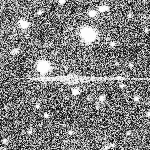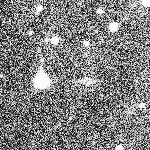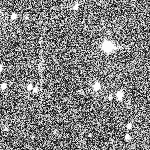Ghosted stars are another common source of false FMO candidates. The mosaic is readout by eight amplifiers in tandem and the shared electronics introduce signal distortions called 'crosstalk'. When the signal for a very bright star is readout by one amplifier the star is 'ghosted' into the subimage being read by a neighboring amplifier. The complete image may affected by crosstalk but the effects are only visible to the human eye when the charge is extremely high, as in the case of a saturated star. When CCD wells overflow with charge from a bright star the surplus charge 'bleeds' down the CCD column containing the saturated well (see Electron Bleed tutorial page.) The ghosting of this linear bleed makes the ghosted star look like a (non-uniform width) trail.
Note the vertical or horizontal motion of the ghosted star in the examples below. The 'motion' is differences in pointing from pass to pass. We are not able to return to the exactsame position for each pass so the stars are slightly shifted on the CCD. Since crosstalk is related to the saturated star's position on the CCD (and that position moves as the pointing changes), the ghosted star appears to move. Ghosted stars are characterized by their 'gray, diffuse' appearance and a bulge in the middle (the ghosted body of the saturated star.)
NON-REPORTABLE: Ghosted Star
CHARACTERISTICS:
This is a typical ghosted star. It is a long horizontal line with a bulge in the middle - the lines are crosstalk from pixels saturated by the bright star 'bleeding' charge along CCD columns. Note that our pointing was relatively consistent here - there is little 'motion'.
NON-REPORTABLE: Ghosted Star
CHARACTERISTICS:
Again this is a ghosted star, but it is missing the long 'arms'. Most likely, the arms are missing since the actual star was only bright enough to saturate its actual footprint - not bright enough to bleed charge down CCD columns. Pointing slipped more here than in example 1.




